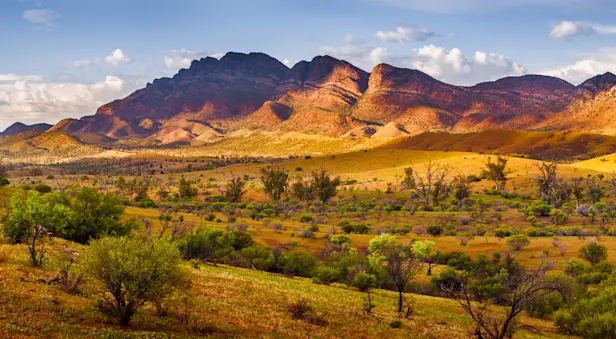
Know Before You Go
What to Pack for Your Australia Adventure
The following packing list contains general recommendations for an Ultimate Australia and Australia South adventure. If you are currently booked on Ultimate Australia or Australia South, please consult your pre-departure materials for the most up-to-date packing list for your trip. You will receive these pre-departure materials 60–90 days before your departure.
Items indicated in color below are typically available in the Nat Hab Gear Store. Please note that due to global supply chain issues beyond our control, we cannot guarantee that every item will always be in stock.
Adventure Guidelines
Temperatures can vary during this adventure. Please reference the Weather & Climate section for weather information specific to your departure date.
The sun in Australia is particularly damaging due to the reduced ozone; thus, good sunscreen, lightweight, long-sleeved shirts and a hat are essential for your protection.
All snorkeling gear is provided by Nat Hab (only for Ultimate Australia)
Clothing
Lightweight neck gaiter (included in your pre-departure package)
—Provides sun, wind and/or dust protection.Lightweight, breathable waterproof rain jacket and rain pants
—Waterproof, not just water resistant. Your rain jacket should have a hood. These may be your most useful pieces of clothing as you will be walking in areas where it could drizzle all day or, at times, rain down in buckets!Sturdy lightweight hiking shoes
4–5 short-sleeved T-shirts
—Avoid bright colors that may attract insects. Moisture-wicking fabric if preferred.1–2 pairs of shorts
2–4 pairs of pants
1 pair of nylon zip-off pants.
—These are great for hiking as they are great for cool mornings and warmer afternoons.Bathing suit
Sport sandals (i.e. Tevas, Chacos, Keens, etc.)
Several pairs of lightweight hiking socks
—Moisture-resistant/moisture-wicking socks are preferred. Cotton socks are not recommended for hikes.Comfortable sneakers or walking shoes
Lightweight sleepwear
Underwear
Rash Guard for snorkeling (only for Ultimate Australia)
Additional Items
Cash
—For discretionary gratuities (you may want to bring envelopes for discreet presentation)
—For personal spending (souvenirs, Internet use, or food and beverages not included in your trip fee)Binoculars
—Binoculars are essential for this adventure! A good quality pair with a magnification of 8x30 or 10x40 will definitely enhance your wildlife-viewing experience, and you will get the most out of them if you practice using them at home and make a habit of having them with you regularly on the adventure. We strongly suggest that each client bring his or her own pair of binoculars as you will be using them continuously.Water-resistant daypack (to carry camera gear and other equipment during outings)
Reusable water bottle (included in your pre-trip package)
—In our continuing effort to operate our adventures with as little impact on the environment as possible, you will receive a reusable water bottle (unless you opted out on your Booking Form) to take with you on your adventure. We will provide drinking water throughout the adventure for you to refill your bottle. By doing this, you will avoid using multiple disposable plastic bottles.Outlet adapter and/or power converter
Headlamp with spare batteries (optional)
—Although not required, consider a headlamp with a red filter for possible evening wildlife walks.Sunglasses (with UV filter and secure strap)
Hairdryer (optional)
—Hairdryers are available at all accommodations either in the room or at reception.Toiletries in reusable bottles to minimize waste
—Shampoo, soap and conditioner will be provided at all our accommodations.Sunscreen and lip balm (at least SPF30)
—Consider reef-safe sunscreens to protect the delicate underwater environment.Prescription medications and favorite remedies
—For headaches, colds, upset stomach, etc.Motion sickness medication
—If you are sensitive to motion sickness, we strongly recommend you come prepared. Ask your doctor about motion sickness patches.Insect repellent and anti-itch ointment
—We recommend DEET-free, non-toxic repellent.Prescription glasses/contact lenses
—Disposable contacts for snorkeling can be handy.Hand sanitizer
Earplugs
Reusable waterproof bags
—Several sizes for wet or dirty clothing and to protect camera equipment.Hiking poles (optional)
—If you are bringing hiking poles, they must be able to fit in your check-in luggage, as you generally will not be allowed to carry them on the plane.
Pack Your Bags for an Australia Adventure

Australia South: Tasmania, Kangaroo Island & the Great Ocean Road
Discover the diverse landscapes and ecology of far-south Australia as we explore four national parks and a host of private nature reserves teeming with endemic and endangered wildlife.































